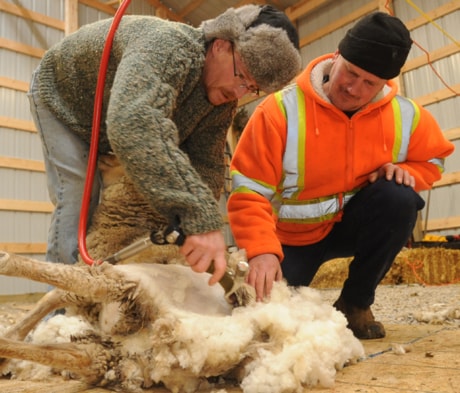LESLIEVILLE — A naked ewe is a happy ewe. That could be why the Turuk ewes, heavily pregnant, don’t kick up more of a fuss when the sheep shearer comes knocking.
Harvesting the wool is really a byproduct of the business for lamb producers Rod and Jacquie Turuk, who are happy enough if the income from the wool is enough to cover the cost of having their sheep shorn.
Removing a year’s growth of fleece is a necessary step for the Turuk’s 130 ewes, whose new lambs are due early in March.
If they are still wearing their wool when the lambs start to come, the ewes will seek a cooler place to give birth. The result is that tiny lambs arrive into a cold bed of snow, said Jacquie.
Liberating them from their coats encourages the ewes to seek a warmer birthing site, like the shelter of their barn, she says.
The annual shave also gives producers a means of assessing the body condition of their animals, which is much more difficult to evaluate when they’re buried under an eight-centimetre layer of wool.
The Turuks are now trying a new way to get their sheep shorn while hosting a social event for fellow producers.
For the first time this past weekend, they hosted the Alberta Lamb Producers annual shearing school, bringing current and prospective sheep producers from across the province to learn from a man who was only eight years old when he sheared his first sheep.
Born on New Zealand’s north island, Laurence Read moved 21 years ago to Maple Creek, Sask., as part of an international agricultural exchange program.
He now keeps his own flock near Silver Valley, about an hour and 20 minutes north of Grande Prairie, supplementing his income building custom fences, shearing sheep and teaching his skills to fellow producers.
In his best year since arriving in Canada, Read sheared 14,000 animals, earning a total income that amounted to $65,000 in today’s dollars.
Using a collection of electric sheep shears provided by the Calgary Stampede for the two-day course, Read split his class of 10 students into pairs, showed them the ropes and then had them sharpen their skills on the Turuk flock.
Students got a safety lesson during morning coffee on Saturday, when one pair left a clipper hanging from its motor.
Already deadly looking with its long metal teeth, the clipper is capable of inflicting grievous injury if someone were to accidently start the motor while it is hanging from the cable that powers its blades, said Read.
To bring his point home, Read took hold of the cable and then pulled the cord to start the motor. The clipper spun on the end of its cable like an electric piranha, looking for something to bite.
The clipper’s wicked-looking blades have to be sharpened from time to time, but remain well lubricated in the hands of an experienced shearer, said student Terence Quinlan while cleaning between the teeth of the set he and partner Kathleen Raines had been using.
A skilled shearer takes advantage of the lanolin produced naturally by the sheep’s wool to keep the blades well lubricated, said Quinlan.
The shearer’s primary job, said Read, is to get the wool off the sheep as cleanly as possible in preparation for the mill. Mill operators don’t like to get wool that’s been cut twice because the first cut was too far off the animal’s hide, he said.
While competitive shearers can do the job in under a minute, it’s best to take the time needed to do a proper job, said Read. His best time is about 45 seconds. The world record is 23 seconds.
Inevitably, some animals are going to get nicked from time to time, said Jacquie. But farmers don’t want to see their animals suffer stress or injury and they especially don’t like their flocks heading back to pasture looking ragged and bedraggled, she said.
The Turuk’s are already looking forward to making the shearing class an annual event on their farm. It’s not for everyone, because the farm needs to have the facilities to host the school and provide lunch, snacks and coffee for the participants.
Considering, however, that it costs $4 per ewe to hire the work out, Jacquie has found hosting the school to be worth the effort.
Sheep production is the one sector in Canada’s livestock industry that has remained profitable, she said. While Rod works off the farm, their flock earns enough money to pay the mortgage.
With Alberta producers raising only 50 per cent of the lamb needed to meet domestic consumption of fresh lamb, it’s an industry that still has plenty of room to grow, she said.
bkossowan@www.reddeeradvocate.com
